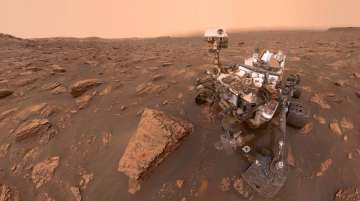NASA's Curiosity rover snaps a selfie before the great Martian dust storm
The Martian dust storm has grown in size and is now officially a "planet-encircling" (or "global") dust event, according to Bruce Cantor of Malin Space Science Systems, San Diego.

NASA's Curiosity rover captured a cool selfie during an 'unprecedented' massive dust storm on Mars. The Red Planet was much engulfed by the storm of tiny dust particles over last two weeks which prompted NASA's Opportunity rover to suspend science operations. But, across the Mars, NASA's Curiosity rover, which has been studying Martian soil at Gale Crater, is expected to remain largely unaltered by the dust. The Opportunity rover has essentially witnessed day turn to night, with little to no sunlight filtering down to the robot and leaving its solar panels and batteries craving energy.
The Martian dust storm has grown in size and is now officially a "planet-encircling" (or "global") dust event, according to Bruce Cantor of Malin Space Science Systems, San Diego. He is deputy principal investigator of the Mars Color Imager camera (MARCI) on board NASA's Mars Reconnaissance Orbiter.
However, Curiosity is on the other side of the planet from Opportunity, the dust has steadily expanded over it, more than doubling over the weekend. . "Tau", the sunlight-blocking haze, is currently above 8.0 at Gale Crater-- which is considering as the highest tau the mission has ever recorded. It was last measured 11 over Opportunity, thick enough that accurate measurements are no longer possible for Mars' oldest active rover.
NASA's scientists who are watching from the ground, Curiosity provides ana unprecendented window to answer some questions. One of the greatest is: why do some Martian dust storms last for months and grow massive, while others stay small and last only a week?
"We don't have any good idea," says Scott D. Guzewich, an atmospheric scientist at NASA Goddard Space Flight Center in Greenbelt, Maryland, leading Curiosity's dust storm investigation.
He points out Curiosity, plus a fleet of spacecraft in the orbit of Mars, will allow scientists for the first time to collect a wealth of dust information both from the surface and from space. The last storm of global magnitude that enveloped Mars was in 2007, five years before Curiosity landed on the Mars.
NASA's Curiosity's engineers for Jet Propulsion Laboratory in Pasadena, California, have studied the potential for the growing dust storm to affect the rover's instruments, and say it poses little risk. The biggest impact is to the rover's cameras, which require extra exposure time due to the low lighting. The rover already routinely points its Mastcam down at the ground after each use to reduce the amount of dust blowing at its optics.
Martian dust storms are common in Mars, especially during southern hemisphere spring and summer, when the planet is closest to the Sun. As the atmosphere warms, winds generated by larger contrasts in surface temperature at different locations mobilize dust particles the size of individual talcum powder grains. Carbon dioxide frozen on the winter polar cap evaporates, thickening the atmosphere and increasing the surface pressure. This enhances the process by helping suspend the dust particles in the air. In some cases, the dust clouds reach up to 40 miles (60 kilometres) or more in elevation.
Though these storms are common, Martian dust storms typically stay contained within a local area. By contrast, the current storm, it is bigger than North America and Russia combined, if it were happening on Earth, says Guzewich.
The dust storm may seem exotic to some Earthlings, but it's not unique to Mars. Earth has dust storms, too, in desert regions such as NorthAfrica, the Middle East, and the southwest United States.
But conditions on Earth prevent storms from spreading globally, said Ralph A. Kahn, a Goddard senior research scientist who studies the atmospheres of Earth and Mars. These include the structure of our thicker atmosphere and stronger gravity that helps settle the dust. Earth also has vegetation cover on land that binds the soil with its roots and helps block the wind and rain that wash the particles out of the atmosphere.